Exploring Sonar Kella (সোনার কেল্লা) - The Golden Fortress City of Jaisalmer in Rajasthan, India: the Shining Jewel of the Great Indian Thar Desert
 |
| সোনার কেল্লা: The Golden Fortress, Jaisalmer |
After exploring the "Blue City" of Jodhpur, we reach Jaisalmer - the "Golden City" of Rajasthan which shimmers like a mirage amidst the vast expanse of the Thar Desert. Its yellow sandstone ramparts, kissed golden by the desert sun, rise majestically above the dunes, whispering tales of a glorious past. But Jaisalmer is more than just a postcard-perfect desert paradise; it's a living tapestry woven with threads of history, culture and captivating charm.
Nestled in the heart of the Thar Desert, Jaisalmer stands as a testament to the rich history, vibrant culture and architectural marvels of Rajasthan, India. Known as the "Golden City" due to its distinctive yellow sandstone architecture, Jaisalmer is a treasure trove of heritage, offering visitors a unique blend of history, significance and captivating attractions.
Jaisalmer's history dates back to the 12th century when it was founded by Maharawal Jaisal Singh, a Rajput king. The city's strategic location along the ancient Silk Route played a pivotal role in shaping its destiny. Over the centuries, Jaisalmer flourished as a prominent trading center, connecting India with Central Asia and beyond. The city's historical significance is evident in its well-preserved forts, havelis and temples.
The significance of Jaisalmer lies in its cultural and historical contributions to the region. The city's forts, particularly the iconic Jaisalmer Fort, showcase the architectural brilliance of Rajput rulers. Jaisalmer served as a major outpost for caravans, facilitating trade and cultural exchange between the East and West. Today, it stands as a living testament to the valor and opulence of Rajasthan's past.
Jaisalmer's culture is a vibrant tapestry woven with the threads of Rajasthani traditions. The city hosts various cultural festivals, such as the Desert Festival, where locals showcase traditional dance forms, music and folk art. The colorful attire of the people, adorned with intricate embroidery and mirror work, adds to the visual splendor of Jaisalmer. The warmth of Rajasthani hospitality is palpable as visitors immerse themselves in the local way of life.
The "Shonar Kella" Connection
"Sonar Kella" (সোনার কেল্লা) is a renowned Bengali film directed by the legendary filmmaker Satyajit Ray. Released in 1974, the film is based on Ray's own novel of the same name and is part of the Feluda series. The story revolves around Feluda, a private investigator and his young cousin Topshe, as they embark on a thrilling journey to Jaisalmer in search of a mysterious golden fortress, Sonar Kella.
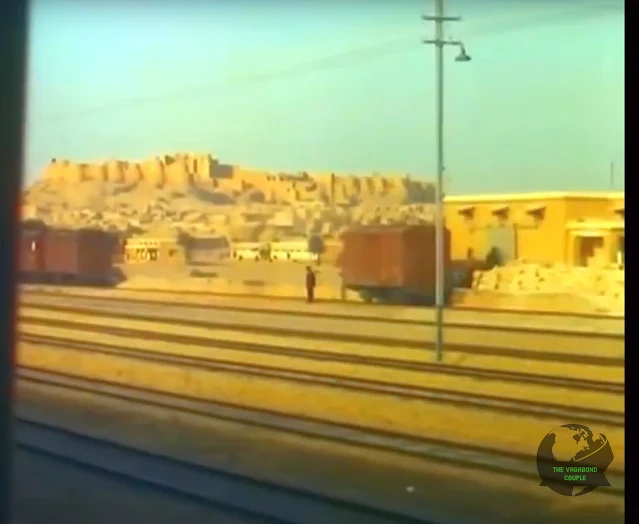 |
| The golden fortress of Jaisalmer: Scene from Sonar Kella (Bengali, 1974) |
"Sonar Kella" remains one of Satyajit Ray's most beloved works, appreciated not only for its engaging mystery but also for its portrayal of Jaisalmer and the cultural intricacies of Rajasthan. The film has stood the test of time and continues to be celebrated by audiences and critics alike. The Golden Fortress of Jaisalmer now stands as a place of pilgrimage for Bengalis across the world.
Feluda, portrayed by Soumitra Chatterjee, is a sharp and astute detective with a penchant for solving complex mysteries. In "Sonar Kella," he is approached by a child, Mukul, who claims to have memories of a past life in which he lived in a golden fortress in the deserts of Rajasthan.
 |
| Pokhran - Jaisalmer Highway: Scene from Sonar Kella (Bengali, 1974) |
Intrigued by the boy's story, Feluda decides to investigate and, accompanied by Topshe (played by Siddhartha Chatterjee) and their comical friend Jatayu (Santosh Dutta), sets out for Jaisalmer. The trio encounters various challenges and adventures on their way to uncover the truth behind the boy's memories and the elusive golden fortress.
Satyajit Ray masterfully captures the essence of Jaisalmer in "Sonar Kella." The film showcases the city's magnificent architecture, the majestic Jaisalmer Fort and the mesmerizing landscapes of the Thar Desert. The golden hues of the city become an integral part of the narrative, creating a visual treat for the audience.
 |
| Chasing the train to Jaisalmer on camelback: Iconic scene from Sonar Kella (Bengali, 1974) |
As the protagonists navigate the narrow lanes of the Jaisalmer Fort, interact with the locals and delve into the history and culture of the region, viewers are treated to a cinematic experience that goes beyond the mystery at hand. Ray's attention to detail and the authenticity of the settings make Jaisalmer a character in itself in the film.
"Sonar Kella" also delves into the cultural nuances of Rajasthan. The film beautifully captures the vibrant traditions, folk music and colorful festivals of the region. Feluda's interactions with the locals, including a memorable encounter with a camel trader, add layers of cultural richness to the narrative.
The Road to Jaisalmer: Pokhran and Ramdeora
Leaving Jodhpur around noon, we make a brief breakfast stop at Haveli Resort just west of Kayalan Lake.
 |
| Haveli Resort, Lordi Daijagra, Rajwa, Rajasthan |
As we drive from Jodhpur to Jaisalmer, we are following Feluda's footsteps in "Sonar Kella" like we were on Sherlock Holmes' Reichenbach Falls trail in Switzerland. We come up from Jodhpur on National Highway 125 (Jaisalmer - Jodhpur Rd) which turns west towards Pokhran at Gumanpura, Kota.
 |
| National Highway 125: Jaisalmer - Jodhpur Road approaching Biramdeogarh |
When we reach Pokhran, we see signs for Ramdevra (Ramdeora) which is just 11km north of Pokhran. Ramdeora is the rail station where Feluda and company get on a train to Jaisalmer after an epic but failed chase of the train on camelback.
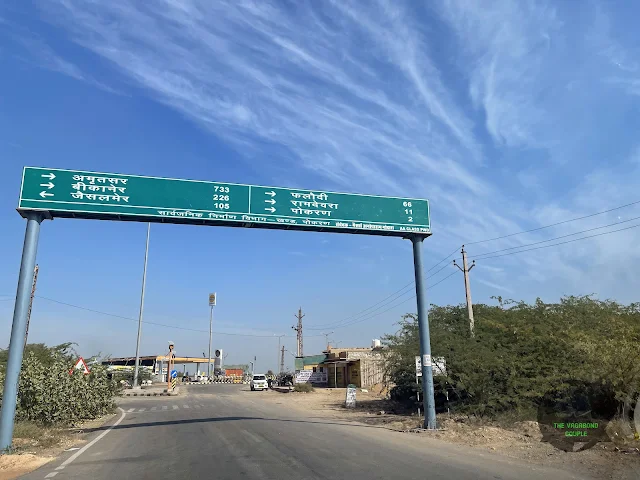 |
| 2 km from downtown Pokhran: Ramdeora is 11 km to the north, Jaisalmer is 105 km west from here |
We break for lunch in Pokhran at the Pokhran Desert Resort.
 |
| Pokhran Desert Resort |
Pokhran is also famous as India's nuclear test site - the Pokhran Test Range. On May 18, 1974, India conducted its first underground nuclear test here, codenamed "Smiling Buddha," at Pokhran. This event surprised the international community and sparked international condemnation. After a 24-year hiatus, India conducted a series of five nuclear tests also at Pokhran on May 11 and 13, 1998, called "Pokhran-II." This further intensified international pressure and sanctions against India. India subsequently declared itself a nuclear-weapon state in 1998 and maintains a policy of nuclear deterrence. While Pokhran remains an important testing facility for India's nuclear program, details of further tests are not publicly disclosed.
In modern times, this ancient place has a EV charging station!
 |
| EV Charging Station at Pokhran Desert Resort parking lot |
Continuing the road trip, NH25 meets National Highway 11 at Pokhran. We get on westbound NH11 towards Jaisalmer and immediately see the railway track to Jaisalmer to our left. An attempted murder on a train on this track by the fake globetrotter is also averted by an astute Feluda.
 |
| NH11: Railway tracks from Ramdeora (Ramdevra) to Jaisalmer |
It is just about 4 PM when we see the sign welcoming us to Jaisalmer.
 |
| Welcome to the Golden City of Jaisalmer |
We drive into the city of Jaisalmer and stop at the Gadisar Lake right around the magic window of the setting sun. We also get a first glimpse of the Jaisalmer Fort on our way to the parking lot of Gadisar Lake.
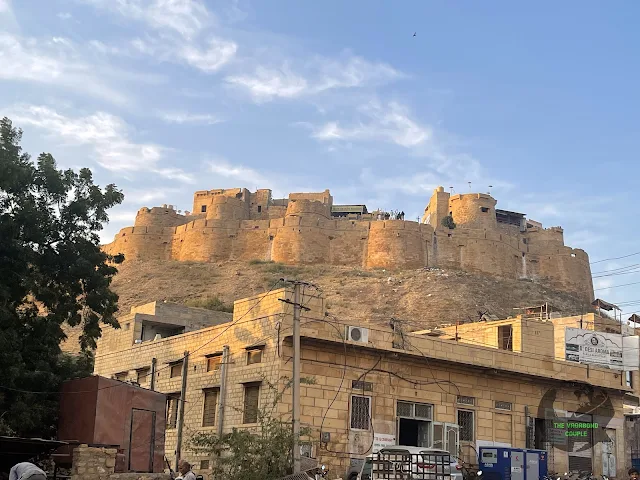 |
| The Golden Fort of Jaisalmer |
Rajasthan's architecture is characterized by the extensive use of locally available materials and one such material that dominates the landscape is sandstone. The region is blessed with vast deposits of high-quality sandstone, notably the warm-toned, golden-yellow variety known as "Jaisalmer stone" or "Yellow sandstone." This distinctive hue imparts a timeless elegance to the structures, creating a mesmerizing interplay of light and shadow.
Gadisar Lake: A Serene Oasis in the Golden City of Jaisalmer
Nestled amidst the golden sands of the Thar Desert, Gadisar Lake shimmers like a jewel in the heart of Jaisalmer, Rajasthan. This man-made wonder, boasting a rich history and captivating beauty, is more than just a water body; it's the lifeblood of the Golden City.
 |
| Gadisar Lake |
Gadisar Lake's tale is intertwined with the very origins of Jaisalmer. Built in the 12th-13th century by Rawal Jaisal, the city's founder, the lake served as a vital source of water for the arid region. This ingenious feat of engineering ensured the city's survival and prosperity, earning Gadisar the moniker "Jaisalmer's lifeline."
 |
| Gadisar Lake |
Centuries later, Maharaja Gadsi Singh further embellished the lake, adding grand ghats, ornate temples and cenotaphs dedicated to deceased royals.
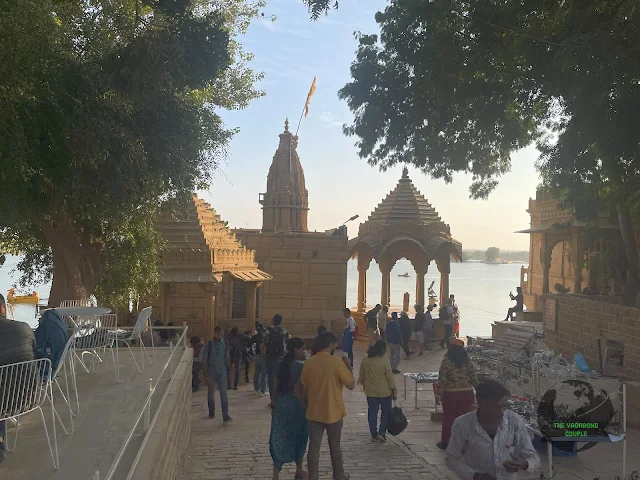 |
| Gadisar Lake |
These architectural marvels, standing gracefully on the lake's edge, whisper tales of a bygone era, adding to the lake's mystique.
 |
| Gadisar Lake |
Beyond its historical significance, Gadisar Lake is a feast for the senses. As the sun paints the sky in hues of orange and gold, the lake transforms into a mirror reflecting the majestic Jaisalmer Fort, creating a picture-perfect postcard.
 |
| Camels and Cows around Gadisar Lake |
Migratory birds flock to the lake's shores, their vibrant wings adding a splash of color to the desert landscape.
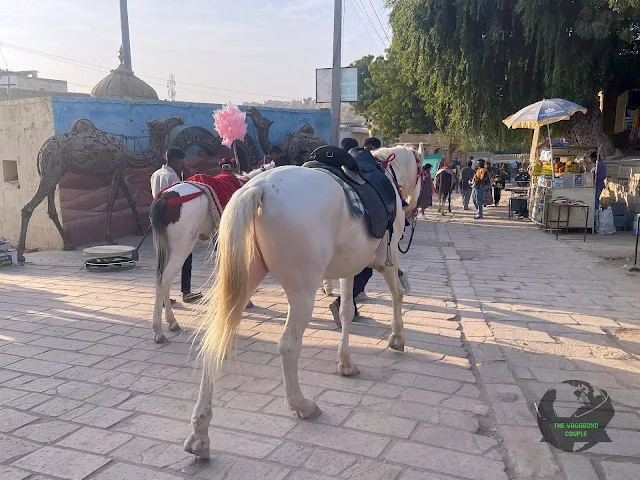 |
| Horses around Gadisar Lake |
Boat rides on the lake's tranquil waters offer a unique perspective of the surrounding beauty. Spot crocodiles basking on the banks, listen to the gentle chirping of birds and soak in the serenity that envelops the area.
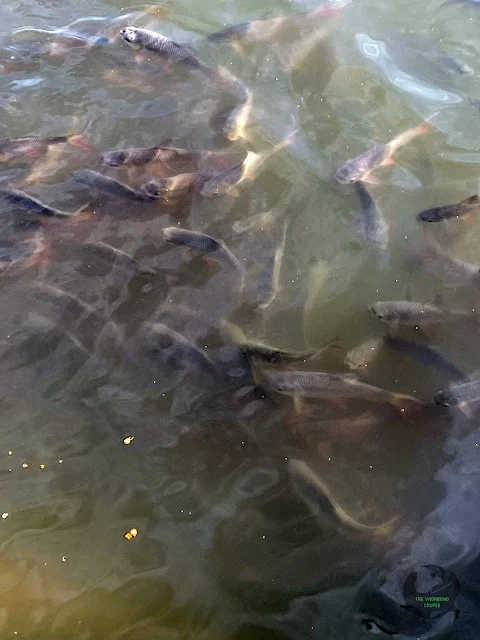 |
| Fish in Gadisar Lake |
As dusk descends, the ghats come alive with the flickering flames of diyas, casting a magical glow on the water.
 |
| Gadisar Lake Ghat |
Gadisar Lake is not just a tourist attraction; it's a vital part of Jaisalmer's cultural tapestry. Locals gather on the ghats to celebrate festivals, chat with neighbors and simply enjoy the peace the lake offers.
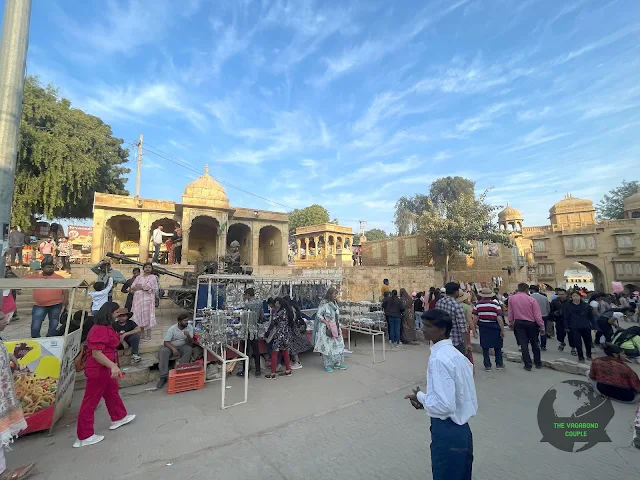 |
| Gadisar Lake Ghat |
The annual Desert Festival, held during February, sees the lake come alive with vibrant music, dance and camel races, showcasing the rich cultural heritage of the region.
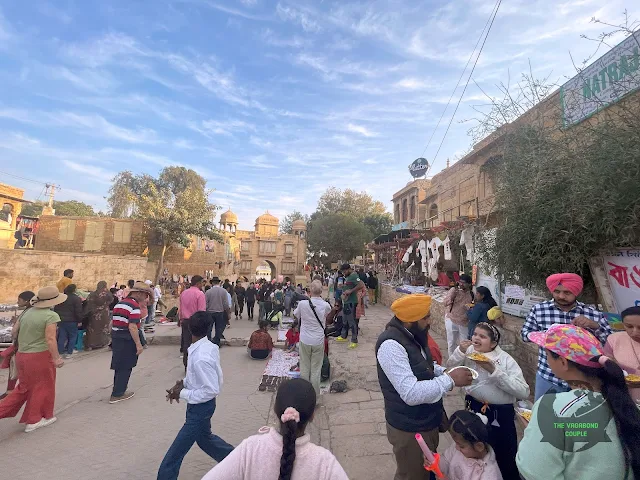 |
| Gadisar Lake Ghat |
Gadisar Lake is open all year round, with the best time to visit being during the winter months (October to March) when the weather is pleasant. Entry is nominal and boat rides and camel safaris are available for a closer look at the lake and its surroundings.
 |
| Boat Ride on Gadisar Lake |
So, if you're ever in Jaisalmer, make sure to visit Gadisar Lake. Let its timeless beauty, rich history and serene atmosphere wash over you and experience the magic of this desert oasis for yourself. Combine your visit to Gadisar Lake with a trip to the majestic Jaisalmer Fort for a complete desert experience.
 |
| Street between parking area and Gadisar lake |
Don't miss the breathtaking sunrise and sunset views over the lake. Sample the local Rajasthani cuisine at one of the many restaurants near the lake. Be respectful of the local culture and customs. Gadisar Lake awaits, promising an unforgettable experience in the heart of the Thar Desert. Come, discover its charm and let it weave its magic on you.
Exploring the Ancient Vibrant Bazaars around Fort Road in Jaisalmer
Jaisalmer, the jewel of the Thar Desert, not only captivates visitors with its golden-hued architecture but also enchants them with its lively and bustling bazaars. One of the most charming areas to explore is the Fort Road, which winds its way around the majestic Jaisalmer Fort. This area is a treasure trove of vibrant markets, offering a delightful mix of traditional Rajasthani crafts, textiles and local flavors.
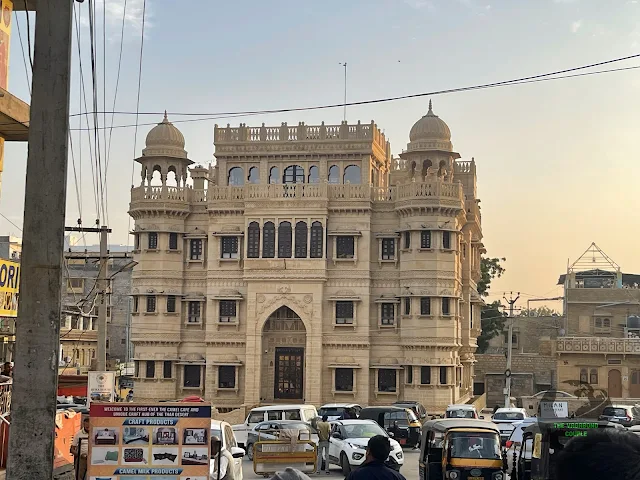 |
| Fort Road |
Sadar Bazaar, situated along Fort Road, is a kaleidoscope of colors, sounds and aromas. This bustling market is a haven for shoppers seeking authentic Rajasthani wares. From intricately embroidered textiles and traditional jewelry to leather goods and antique items, Sadar Bazaar caters to every taste. The rhythmic clinking of bangles, the chatter of vendors and the sweet aroma of street food create a sensory symphony that immerses visitors in the local culture.
 |
| Fort Road |
As one strolls along Fort Road, Manak Chowk (मानक चौक) in Amar Sagar Prol (Amar Sagar Gate) emerges as a textile paradise. The market is adorned with shops showcasing exquisite handwoven fabrics, vibrant tie-dye textiles and intricately embroidered garments. From traditional Rajasthani attire such as bandhani sarees and ghagra-cholis to contemporary fashion with a local twist, Manak Chowk is a haven for textile enthusiasts.
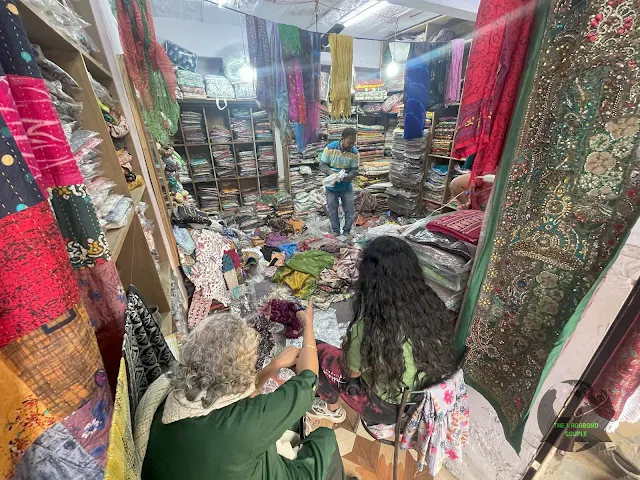 |
| Shopping at Manak Chowk, Fort Road |
For those intrigued by history and antiquities, Pansari Bazaar is a must-visit. This market is filled with shops offering a fascinating array of antique items, including vintage trinkets, old coins and unique artifacts. Pansari Bazaar's rustic charm and the allure of the past make it an ideal spot for collectors and history enthusiasts.
Sonaron Ka Baas, meaning the 'residence of goldsmiths,' lives up to its name with shops specializing in intricate gold and silver jewelry. Skilled artisans showcase their craftsmanship, offering an array of traditional and contemporary designs. Visitors can witness the meticulous process of jewelry-making and even have bespoke pieces created to commemorate their time in Jaisalmer.
No exploration of Jaisalmer's Fort Road is complete without indulging in the delectable local street food. The aroma of spicy snacks, sweet treats and traditional Rajasthani specialties wafts through the air, tempting passersby to sample the culinary delights. From the popular kachoris and samosas to the sweet decadence of jalebis, Fort Road's street food vendors offer a culinary journey that complements the vibrant market experience.
Beyond the commerce and merchandise, Fort Road's bazaars provide a unique opportunity for cultural immersion. Interacting with locals, learning about traditional crafts and witnessing age-old techniques passed down through generations add a layer of authenticity to the shopping experience.
A journey through the bazaars around Fort Road in Jaisalmer is more than a shopping spree; it's a sensory adventure that brings visitors closer to the heart and soul of Rajasthan. The vibrant markets, rich with tradition and culture, reflect the resilience and creativity of the people of Jaisalmer. Whether you're seeking exquisite textiles, indulging in street food, or simply soaking in the atmosphere, the bazaars around Fort Road promise an unforgettable experience that resonates with the spirit of this desert city.
Desert Camping at Sam Sand Dunes, Thar Desert
Our lodging at Jaisalmer is actually in tent camps under the stars at the Great Indian Thar Desert, in a desert camp at Sam Sand Dunes 40 km west of Jaisalmer. It is dark by the time we check into the desert camp.
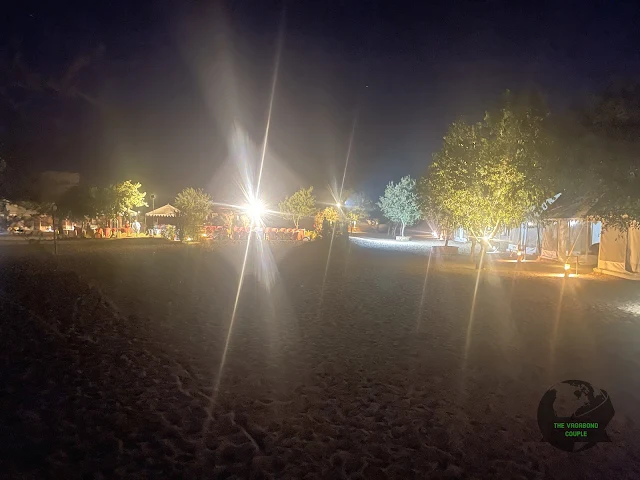 |
| Thar Desert Camp at Sam Sand Dunes |
It is an epic experience at the camp with live cultural performances, 4x4 jeep rides, ATV rides and a sunrise camel safari, all of which we recount in a separate post "A Desert Expedition to Sam Sand Dunes of Thar Desert of Rajasthan: Tent Camping, Camel Safari, Jeep Rides and ATV Adventures".
After returning to the desert camp from Thar desert activities of one morning, we drive the 40 km east to return to the fortress-city of Jaisalmer.
Shonar Kella: The Golden Fortress of Jaisalmer
Dominating the cityscape, the Jaisalmer Fort is a UNESCO World Heritage Site and one of the largest fully preserved fortified cities in the world. Its golden-hued walls, intricate architecture and panoramic views make it a must-visit attraction.
Suraj Prol - Sun Gate
We enter via the Sun Gate (Suraj Prol), the most magnificent and historically significant of the four gateways leading into the majestic Jaisalmer Fort.
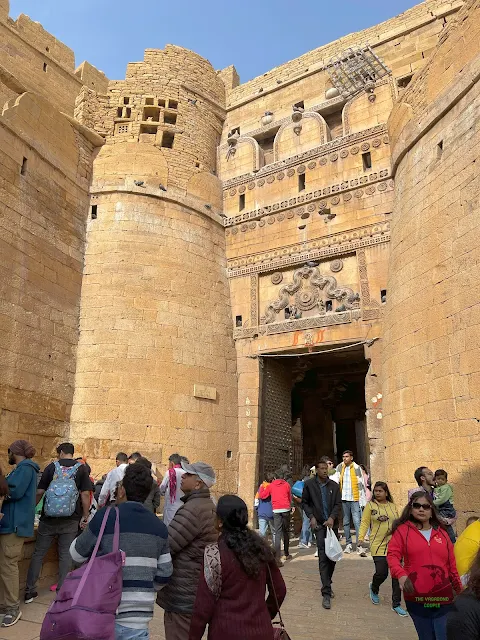 |
| Sun Gate (Suraj Prol) |
Built in 1594 by Maharawal Jaiman Singh Rathor, the Sun Gate stands tall and proud, welcoming visitors with its imposing presence. Constructed from golden honey-colored sandstone, the gate reflects the warm hues of the desert sun, earning its apt name.
Here are some of the key features that make the Sun Gate a standout:
- Architectural Splendor: The gate is adorned with intricate carvings and sculptures depicting mythological figures, floral patterns and scenes from battle. The detailing is particularly impressive on the archway, showcasing the prowess of Rajput craftsmanship.
- Strategic Significance: The Sun Gate served as the main entrance to the fort during its heydays. Its sturdy construction and strategically placed bastions offered formidable defense against enemy attacks. The narrow passageway with sharp turns further enhanced the fort's security.
- Symbolic Importance: The Sun Gate embodies the resilience and power of the Jaisalmer rulers. The rising sun motif carved on the gate symbolizes the hope for a new day and the enduring strength of the Rajput kingdom.
Today, the Sun Gate remains a popular tourist attraction, offering a glimpse into the rich history and cultural heritage of Jaisalmer. Whether you're a history buff, an architecture enthusiast, or simply a seeker of breathtaking views, the Sun Gate is a must-visit on your trip to this Golden City of the desert.
Ganesh Prol - Ganesh Gate
Ganesh Prol (Ganesh Gate) which is located on the northeastern side of the Jaisalmer Fort facing the town is named after Lord Ganesha, the Hindu deity with the head of an elephant. The gate is adorned with an image of Lord Ganesha with beautiful motifs, including floral patterns and mythological figures.
It is considered auspicious to pass through another one of the main gates for entry into the fort complex.
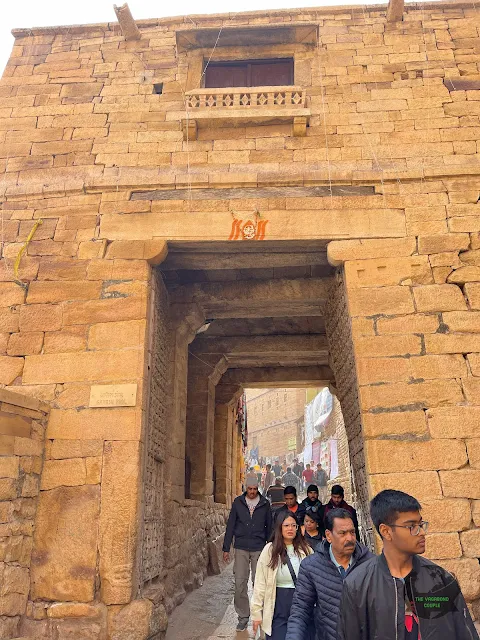 |
| Inside of Ganesh Gate (Ganesh Prol) |
Ganesh Pol was built along with the Jaisalmer Fort in the 12th century by Maharaja Rawal Jaisal. The presence of Lord Ganesha, considered the remover of obstacles, at the entrance symbolizes a spiritual and protective aspect for those entering the fort. Visitors to Jaisalmer often admire Ganesh Pol not only for its architectural beauty but also for the cultural and religious ambiance it adds to the overall experience of exploring the Jaisalmer Fort. It stands as a gateway to the rich history and heritage encapsulated within the fort walls.
Dussehra Chowk
Dussehra Chowk is a large courtyard situated inside the Jaisalmer Fort complex. It was once used to celebrate annual festivals like Dussehra and for listening to petitions and entertainment programs.
 |
| Dussehra Chowk courtyard |
As we walk the narrow alleys of Khejer Para towards the Cannon Point Panoramic City View, we pick up Rajasthani Hindu headgear. The unique headgear, particularly for men, is dominated by the magnificent turban, known locally as pagri or safa. The world of Rajasthani Hindu headgear is vast and diverse!
Putting on the Rajasthani Safa
A pagri or safa refers to a large, colorful turban typically worn by men. It's not just a piece of cloth; it's a cultural symbol deeply intertwined with identity, social status and occasion. Variations include Jodhpuri Pagri - large and voluminous with distinctive pleats at the back, often worn by royalty; Marwari Pagri (the ones we got) - smaller and more compact, usually with a single layer of folds; Bhatti Pagri - long and flowing with a distinctive fan-shaped crest, worn by the Bhatti tribe.
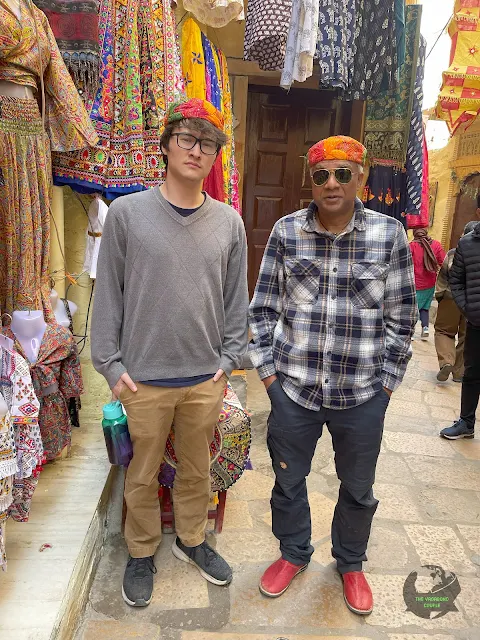 |
| Traditional Rajasthani Safa headgear |
Traditional Rajasthani Hindu Headgear for women include the Ghoonghat - a veil usually attached to the saree, covering the face partially or fully; the Borla - a colorful headband adorned with sequins and mirrors, often worn by tribal women; and the Chunni - a long scarf draped over the head and shoulders, used both for practicality and ornamentation.
Wearing a headgear is considered a mark of respect and signifies a man's honor and social standing. The size, style and color can all indicate caste, community and even profession.
The turban offers protection from the harsh desert sun and winds. It can also be used as a blanket, pillow, or even a sling for carrying goods.
Certain colors and styles hold religious significance. For example, ochre is worn by mendicants, saffron by guests at weddings and white by the Bishnoi community.
Cotton, silk and synthetic fabrics are used, with silk reserved for special occasions. A vibrant palette is employed, from ochre and saffron to emerald green and deep blue. Colors often signify occasion and social status. Patterns like paisleys, stripes and checks are common, with embroidery and embellishments adding further flair.
Cannon Point Panoramic City View
The Cannon Point at Jaisalmer Fort is known for its stunning panoramic views of the city and surrounding Thar Desert. It's a popular spot for tourists to capture breathtaking photos and soak in the panoramic vistas, especially during sunrise.
 |
| Jaisalmer Fort Cannon Point Panoramic City View |
Witness the Golden City of Jaisalmer sprawl out before you, with its honey-colored sandstone buildings and intricate havelis.
Gaze out at the vast expanse of the Thar Desert, stretching towards the horizon in a sea of golden sand. Learn about the fort's defensive past, as cannons were once positioned here to ward off invaders. Capture stunning panoramic shots of the city and desert, making for lasting memories of your Jaisalmer visit.

Cannon Point is open from 6:00 AM to 10:00 AM (though the fort itself is open longer). The Entrance Fee is included in the fort entrance ticket.
Residential Houses of the Fort of Jaisalmer
Inside the magnificent Jaisalmer Fort, you'll find not just imposing walls and historical landmarks, but also a vibrant community residing in traditional haveli houses. These havelis offer a captivating glimpse into the everyday lives of Jaisalmer's residents and their unique heritage.
Here's what you can expect to find regarding residential houses within the Jaisalmer Fort:
Types of Havelis
- Ancestral Homes: Many havelis have been passed down through generations, showcasing traditional Rajasthani architecture and craftsmanship.
- Converted Homestays: Some havelis have been lovingly transformed into homestays, offering tourists an authentic experience of living within the fort walls.
- Local Businesses: A few havelis house shops selling souvenirs, textiles and handicrafts, adding to the bustling atmosphere.
Architectural Features
- Golden Sandstone Facades: Most havelis are built from Jaisalmer's signature honey-colored sandstone, reflecting the warm desert sun.
- Intricate Carvings: Exquisite carvings depicting floral motifs, mythological figures and geometric patterns adorn the walls and doorways.
- Jharokhas: Ornate latticed windows, traditionally used by women to observe life outside while maintaining privacy.
- Courtyards: Open courtyards provide natural light and ventilation and often act as communal spaces for residents.
Lifestyle of Residents
- Generations Cohabiting: It's common for multiple generations of families to live together in these havelis, fostering a strong sense of community.
- Traditional Practices: Observe glimpses of everyday life, from women cooking in clay ovens to children playing in courtyards.
- Cultural Experiences: Some havelis offer opportunities to learn about local customs, music and handicrafts.
Impact on Fort Ambience
- Living History: The presence of residents adds a dynamic element to the fort, making it feel like a living and breathing space, not just a historical monument.
- Authentic Charm: Walking through the narrow lanes and seeing residents go about their daily lives creates a more authentic experience of Jaisalmer.
- Economic Boost: Local businesses within the havelis contribute to the economic well-being of the community.
Things to Remember
- Respect the privacy of residents while exploring the havelis.
- Be mindful of noise levels and cultural sensitivities.
- Support local businesses by purchasing souvenirs or handicrafts.
Overall, the residential houses within Jaisalmer Fort offer a unique opportunity to understand the rich cultural heritage and vibrant living history of this iconic landmark. Whether you choose to stay in a haveli homestay or simply explore the streets, you're sure to be captivated by the charm and authenticity of this remarkable community.
Little Tibet Restaurant
The brightly colored Little Tibet Restaurant suddenly appears on the side of a narrow alley near Queens Palace in Khejer Para. It is situated within the bustling marketplace area inside the fort walls, close to the Ganesh Pol entrance. This means you'll be immersed in the vibrant atmosphere of the fort while enjoying your meal.
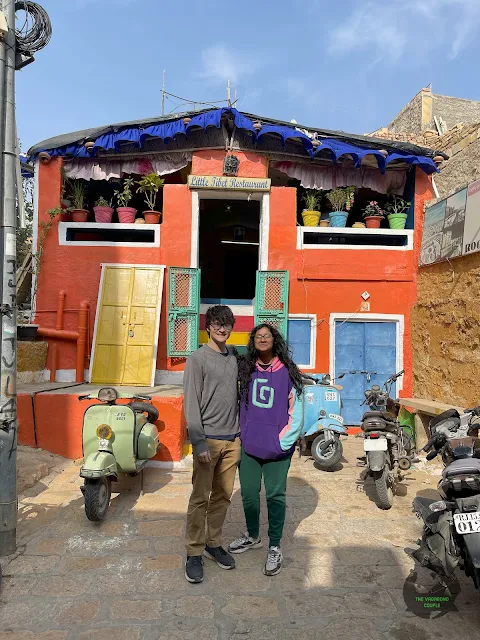 |
| Little Tibet Restaurant inside Jaisalmer Fort |
The restaurant specializes in Tibetan and Indian cuisine. Momos, thukpa noodles and various curries are popular choices. They also offer vegetarian and vegan options.
The restaurant has a simple and casual atmosphere with basic seating and decorations. Its location within the fort itself adds a unique and historic charm to the experience, though the restaurant might be subject to limited opening hours or closure during certain days. It's advisable to check beforehand.
We continue walking the fascinating narrow alleys of the fort as we make our way to the Jain temples. Ah, the narrow alleys of Jaisalmer Fort! These winding lanes, carved into the golden sandstone, are much more than just passageways - they're a tapestry of vibrant life, captivating history and architectural wonder.
 |
| Narrow Alleys and Bazaars of Jaisalmer Fort |
Here's what you can expect to find amidst these meandering alleys:
- A Labyrinthine Experience: Prepare to lose yourself in a maze of narrow lanes, each turn revealing a new surprise. The alleys twist and turn, sometimes dead-ending onto quiet courtyards or bustling bazaars.
- Architectural Splendor: Immerse yourself in the intricate carvings and detailed facades adorning the sandstone houses. Each lane seems like an open-air art gallery, showcasing traditional Rajasthani architecture in all its glory. Look for jharokhas (latticed windows), ornate doorways and colorful frescoes.
- Vibrant Bazaar Atmosphere: Be swept away by the sights and sounds of the bustling bazaars. Local vendors display their wares, from colorful textiles and handcrafted souvenirs to spices and delectable street food. The air buzzes with bartering voices and tempting aromas.
- Glimpses into Local Life: Witness the everyday lives of Jaisalmer's residents. Children playing cricket in the alleys, women hanging up saris to dry, men sipping chai on sun-soaked steps - each scene a window into the local culture.
- Hidden Gems: Keep your eyes peeled for hidden treasures tucked away in the alleys. You might stumble upon a centuries-old temple, a charming tea shop, or an antique shop overflowing with forgotten trinkets.
Tips for Navigating the Alleys
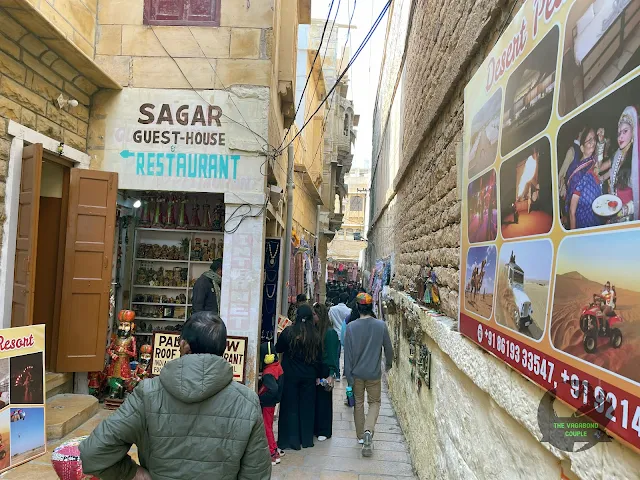 |
| Narrow Alleys and Bazaars of Jaisalmer Fort |
- Wear comfortable shoes, as the uneven terrain can be tricky.
- Carry a water bottle, especially during the hot desert days.
- Respect the privacy of residents and avoid taking intrusive photos.
- Don't be afraid to get lost - that's where the joy of exploration lies!
Chandraprabhu Temple: A Beacon of Jain Faith
Located within the majestic Jaisalmer Fort, the Chandraprabhu Jain Temple is a stunning example of Jain architecture and devotion.
 |
| Chandraprabhu Temple |
Dedicated to the 8th Tirthankara Lord Chandraprabhu, the temple dates back to 1509 and stands as a testament to the rich history and cultural heritage of Jainism in Rajasthan.
Exquisite Architecture
As you approach the temple, its intricate carvings and ornate facade in golden sandstone catch your eye. The temple features a beautiful arched entrance gate, leading to a spacious mandapa (hall) supported by intricately carved pillars.
 |
| Chandraprabhu Temple |
The inner sanctum houses a serene idol of Lord Chandraprabhu in white marble, radiating peace and tranquility.
A Serene Sanctuary
Stepping into the Chandraprabhu Jain Temple is an experience that calms the senses. The muted lighting, intricate carvings and serene atmosphere create a space for quiet contemplation and prayer.
Historical Significance
The Chandraprabhu Jain Temple is one of seven Jain temples built within the Jaisalmer Fort between the 12th and 16th centuries.
 |
| Chandraprabhu Temple |
These temples showcase the flourishing Jain community in Jaisalmer during that period and their intricate architectural skills.
Visiting the Temple
The Chandraprabhu Jain Temple is open to visitors from 9:00 AM to 6:00 PM daily. Entry is free and visitors are requested to dress modestly and maintain respectful behavior within the temple premises.
Things to Remember
- Photography is generally not allowed inside the temple, though it appeared to us people were paying the guards and happily taking pictures.
- Remove your shoes before entering the inner sanctum.
- Speak softly and avoid being disruptive to others who are praying.
More than just a temple, the Chandraprabhu Jain Temple is a window into the rich history and culture of Jainism in Jaisalmer. Its serene atmosphere, exquisite architecture and historical significance make it a must-visit destination for anyone exploring the Golden City.
Akhai Prol (Akhey Prol)
Akhey Prol, also spelled Akhē Prol or Akhai Pol, is one of the four grand entrance gates leading into the majestic Jaisalmer Fort in Rajasthan, India. Its name translates to "The Undying Gate" or "The Eternal Gate" signifying its strength and symbolic importance.
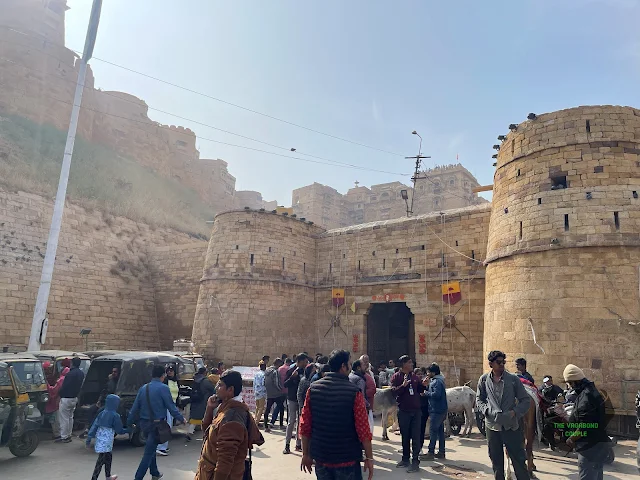 |
| Akhey Prol (Akai Gate) from Fort Road outside the fort walls |
The Akhey Gate was built in the 15th century by Maharawal Jaiman Singh Rathor, making it one of the oldest gates of the fort. Akhey Prol served as a main entrance to the fort during its heydays, as its strategic location on the eastern side offered better protection against enemy attacks. The sturdy construction, featuring thick walls and narrow passageways with sharp turns, further enhanced the fort's defensive capabilities.
Constructed from golden honey-colored sandstone, the gate blens seamlessly with the fort's overall architecture. It is adorned with intricate carvings and sculptures depicting mythological figures, floral motifs and geometric patterns. It features a pointed archway, reminiscent of Rajput architectural style and sturdy flanking bastions for defense.
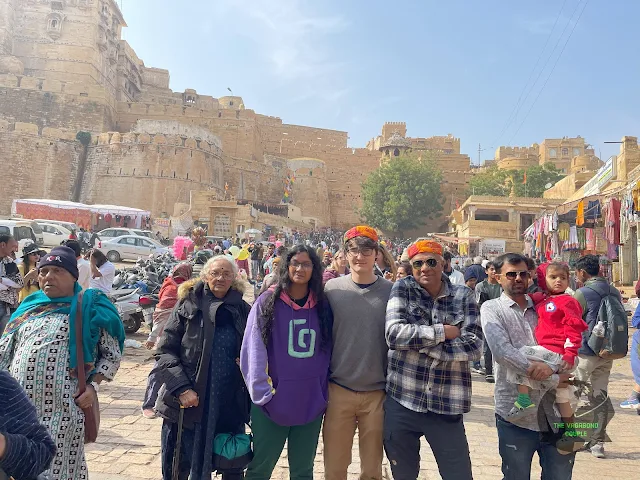 |
| Akhey Prol: Courtyard inside the fort after entering through the gate |
While it was once the main entrance, its role has been partly replaced by Yudhishthira Pol for easier access. Akhey Prol offers a more scenic and historically significant entrance experience compared to the other gates.
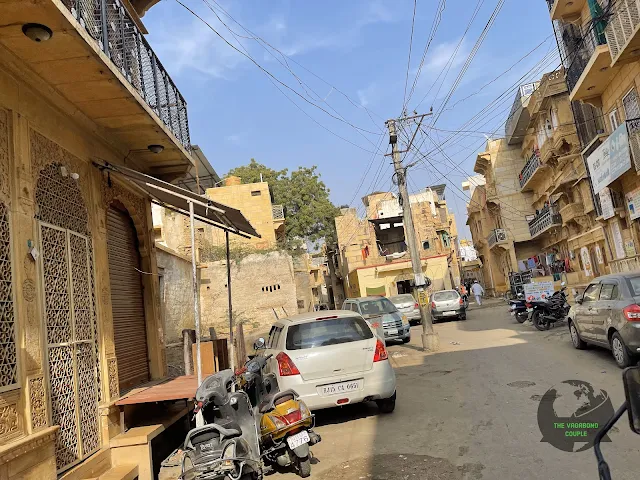 |
| Auto-rickshaw service from outside the Akhey Prol Gate towards Patwon Ki Haveli |
Things to Remember
- The gate is open to visitors during the fort's opening hours (8:00 AM to 6:00 PM).
- Entry is included in the fort entrance ticket.
- Wear comfortable shoes as the path leading up to the gate can be uneven.
- Respect the historical significance of the gate and avoid vandalism or graffiti.
The Sutharpara neighborhood: Carpenters' Quarter
We exit the walled fortress of Jaisalmer via the Akhey Prol gate and proceed towards the legendary Patwon Ki Haveli. We cross Sutharpara on the way to Patwon Ki Haveli.
 |
| A resident washes the golden pavement of a Haveli-lined street at Sutharpara, the Carpenters' Quarter |
This hidden gem nestled within the vibrant city of Jaisalmer offers a unique glimpse into the local culture and rich history, often overlooked by tourists.
A Craftsman's Paradise
Sutharpara, meaning "Carpenters' Quarter," is named after the Suthar community, renowned for their generations-old carpentry skills.
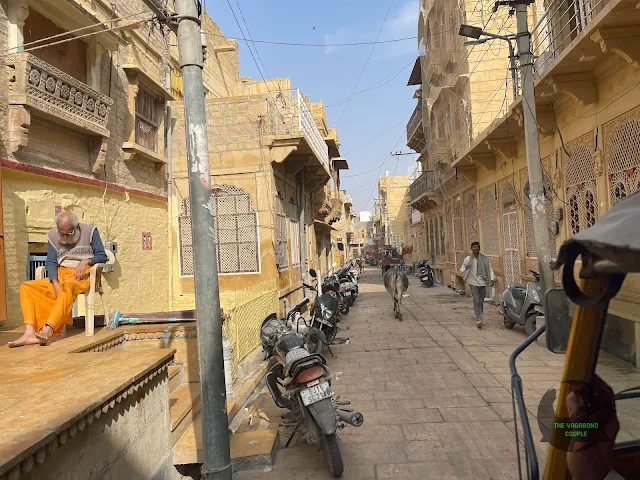 |
| Haveli lined golden street of Sutharpara, the Carpenters' Quarter |
Walking through the narrow lanes, you'll see their workshops filled with the rhythmic clack of hammers and chisels, creating intricate furniture, doors and other items from golden sandstone and wood. Witnessing their craftsmanship firsthand is a fascinating experience.
Living History
Stepping into Sutharpara feels like stepping back in time. The traditional havelis (mansions) built from golden sandstone line the streets, adorned with intricate carvings and colorful painted patterns.
 |
| Moving handlebar of scooter to make space for auto-reickshaw on narrow alley of Sutharpara |
These haven't just been preserved, they're still homes to families, offering a glimpse into their everyday lives and traditions.
Beyond Carpentry
While carpentry takes center stage, Sutharpara also boasts other artisans. Metalworkers, potters and textile weavers showcase their talents in small shops hidden around the neighborhood.
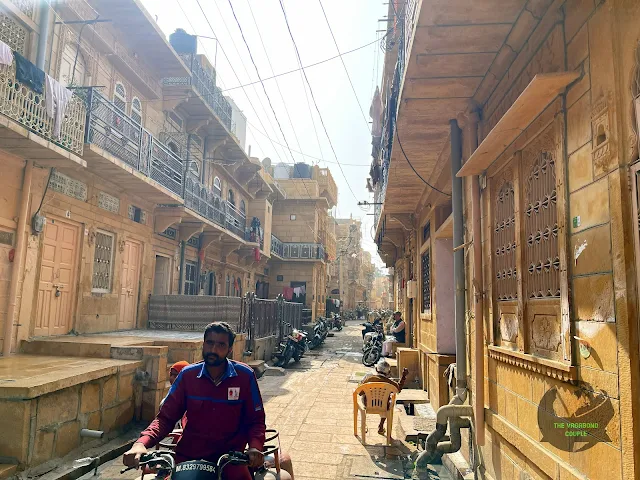 |
| Haveli lined on the sides of golden alley in Sutharpara |
You can find unique souvenirs, colorful fabrics and handcrafted pottery, all imbued with the spirit of the craftspeople who made them.
Authentic Vibe
Unlike the bustling tourist areas of Jaisalmer, Sutharpara retains a quieter, more authentic atmosphere. Children play cricket in the lanes, women chat at doorstep wells and the air is filled with the sounds of daily life rather than tourist chatter.
 |
| Residence and Workshop of Shanti Jewelers Silversmiths on the right |
It's a place to slow down, connect with the locals and experience Jaisalmer beyond the postcard pictures.
Things to Remember
- Sutharpara is best explored on foot, allowing you to wander through the narrow lanes and discover hidden gems.
- Respect the privacy of residents and avoid taking intrusive photos.
- Support the local artisans by purchasing their handcrafted goods.
- Be mindful of your dress code. Avoid revealing clothes and cover your head when entering shops or havelis.
- Sutharpara offers a captivating experience for travelers seeking a slice of authentic Jaisalmer. From witnessing generations-old craftsmanship to discovering local life, it's a place to connect with the heart and soul of the Golden City.
Patwon Ki Haveli: Epitome of Architectural Grandeur in Jaisalmer
Nestled within the golden embrace of Jaisalmer, the "Golden City" of Rajasthan, Patwon Ki Haveli stands as a testament to the opulence and artistic finesse of the bygone era.
A cluster of five havelis, or grand residences, Patwon Ki Haveli is a jewel in the architectural crown of Jaisalmer, captivating visitors with its intricate carvings, historical significance and timeless charm.
Historical Background
Built during the 19th century, Patwon Ki Haveli holds a rich history that echoes the prosperity of the merchants who commissioned its construction.
 |
| Patwon Ki Haveli entrance |
The havelis were crafted by brothers Gumanmal and Kaharmal Patwa and their wealthy family of prominent traders who dealt in gold and silk. These opulent residences were meant to showcase their wealth, influence and refined taste.
Architectural Marvel
Intricate Carvings
Patwon Ki Haveli is celebrated for its exquisite architecture, characterized by intricate carvings that adorn every inch of its façade.
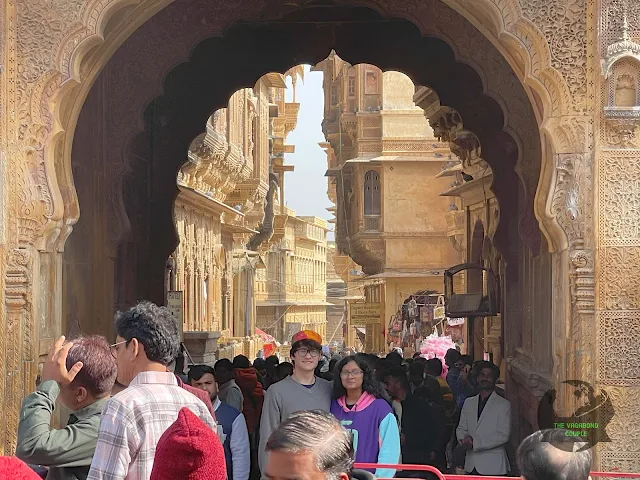 |
| Intricate Yellow Sandstone Carvings start at Patwon Ki Haveli entrance |
The yellow sandstone walls come alive with delicate patterns, filigree work and mesmerizing details. The craftsmanship reflects a fusion of Rajput and Islamic styles, creating a unique visual spectacle.
Jharokhas and Balconies
The haveli is adorned with numerous jharokhas (balconies) that project from the walls, each telling its own story through the finely chiseled designs.
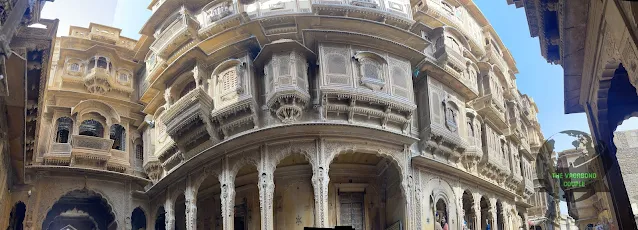 |
| Some of the Jharokas (balconies) at Patwon Ki Haveli |
The interplay of light and shadow on these balconies adds to the enchantment of the haveli, creating a captivating play of patterns.
Architectural Layout
Comprising five havelis, Patwon Ki Haveli is a complex of interconnecting structures. Each haveli has distinct features, contributing to the grandeur of the entire ensemble.
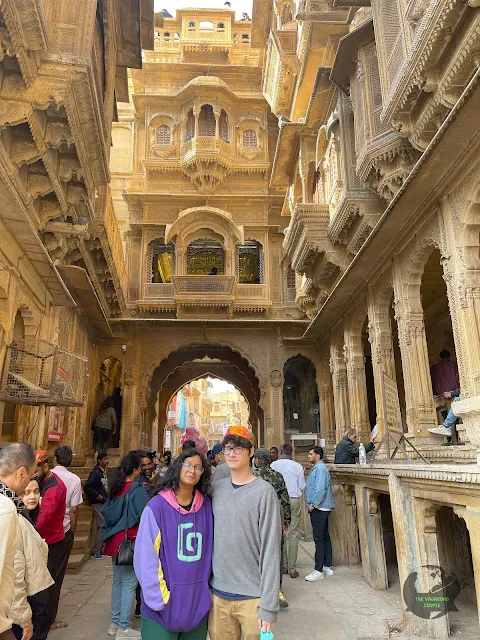 |
| Five interconnected Havelis of Patwon Ki Haveli |
The meticulous planning and execution of the architectural layout showcase the skill of the builders.
Cultural Significance
Beyond its architectural splendor, Patwon Ki Haveli holds cultural significance in the region. It provides a glimpse into the lifestyle, social hierarchy and artistic preferences of the affluent merchants of Jaisalmer during the 19th century.
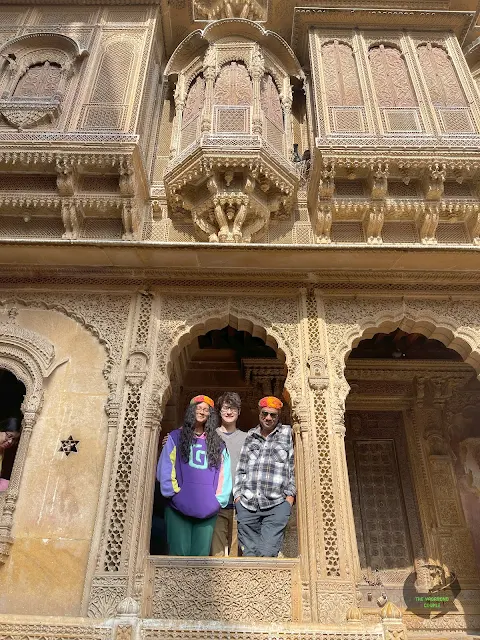 |
| Patwon Ki Haveli |
The haveli complex serves as a living museum, preserving the cultural heritage of the region.
Preservation Efforts
In recent years, efforts have been made to conserve and restore Patwon Ki Haveli to ensure that future generations can appreciate its historical and architectural value. Conservation projects focus on maintaining the structural integrity of the haveli while safeguarding its delicate carvings and heritage.
Visitor Experience
A visit to Patwon Ki Haveli offers a mesmerizing journey into the opulent past of Jaisalmer. As visitors explore the intricacies of the carvings, climb the narrow staircases to the balconies and witness the panoramic views of the city from the haveli, they are transported to an era of grandeur and prosperity.
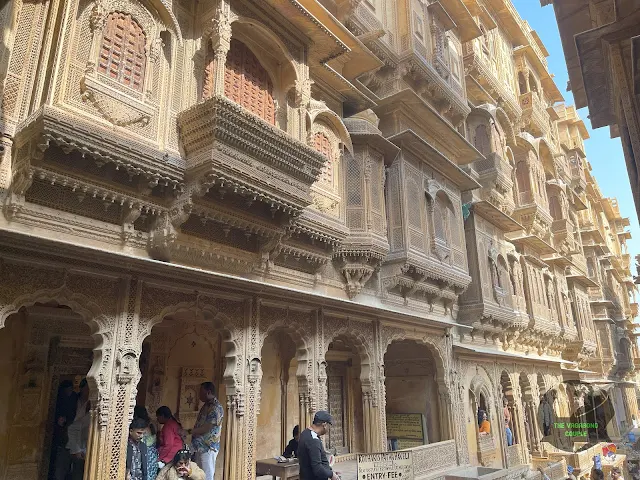 |
| Patwon Ki Haveli |
Prepare to be awestruck by the sight of the havelis' towering honey-colored sandstone facades. Each haveli boasts intricate carvings depicting mythological figures, floral motifs and geometric patterns. These carvings, a masterpiece of craftsmanship, narrate stories from Hindu epics and local folklore.
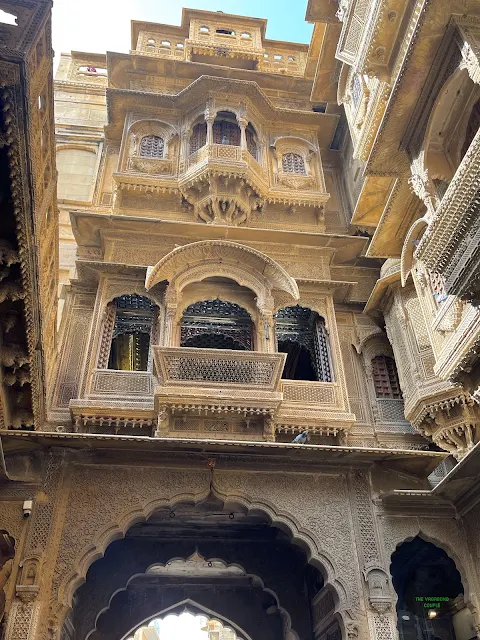 |
| Patwon ki Haveli |
Step into a bygone era as you pass through the ornate arched gateways. Notice the intricate jali work (latticework) and the beautiful peacocks adorning the arches, symbolic of prosperity and good luck.
 |
| Patwon Ki Haveli |
Each haveli's central courtyard is a haven of tranquility. Stroll through the manicured gardens, admire the ornate pillars and soak in the grandeur of the surrounding architecture. In the bygone era, these courtyards served as communal spaces for gatherings and celebrations.
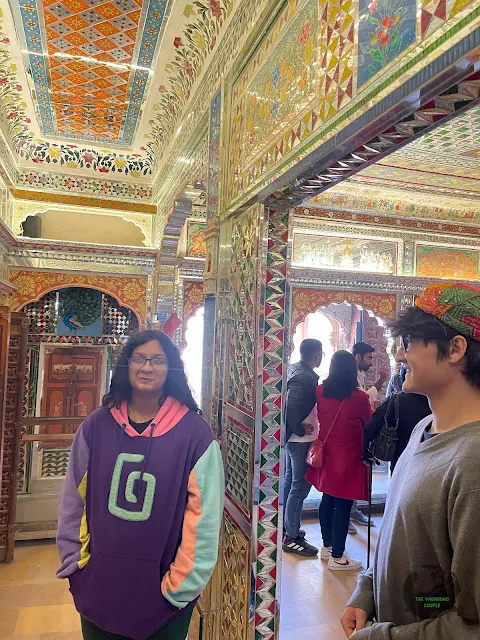 |
| Patwon Ki Haveli |
One of the exhibits in the museum is of weights used in beam balances. These were used to measure weight in units called "Ser" which is no longer in common use. "Ser" was traditionally used for measuring grains, spices and other commodities.
The weight equivalent of a Ser confusingly varied depending on the region and commodity being measured. Here's a breakdown of the different Ser variations used in Rajasthan:
- Jaipur Ser: This was the most common Ser, equivalent to 960 grams or 2.12 pounds.
- Marwar Ser: Used in the Marwar region, it was slightly heavier than the Jaipur Ser, weighing around 1,020 grams or 2.25 pounds.
- Mewar Ser: Used in the Mewar region, it was lighter than the Jaipur Ser, weighing around 880 grams or 1.94 pounds.
- Bikaner Ser: This Ser was even lighter, equivalent to 800 grams or 1.76 pounds.
 |
| "Ser" weight measures for use in weighing scales. Note the name of the place for each. |
The conversion of Ser to other units can be confusing due to these regional variations. It's important to consider the specific context when encountering references to Ser in historical documents or recipes. While Ser is no longer widely used in everyday transactions, it remains an interesting reminder of Rajasthan's traditional measurement systems and cultural heritage.
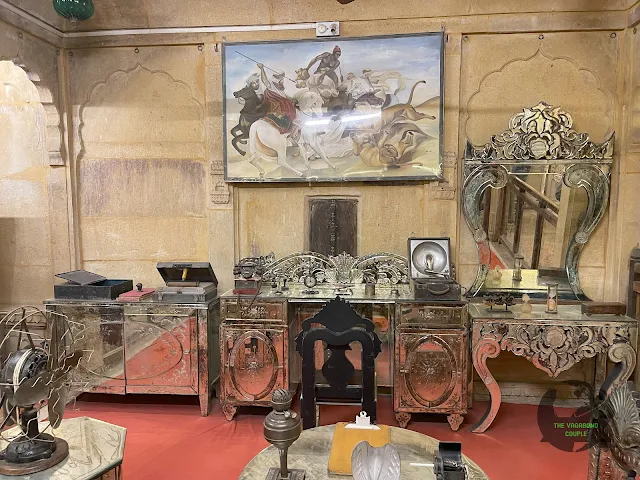 |
| Patwon Ki Haveli |
Wander through the labyrinthine corridors and marvel at the detailed craftsmanship on every wall and ceiling. Look for the exquisite mirrorwork, colorful frescoes and painted floral designs that adorn the interiors. Each room tells a story about the opulent lifestyle of the Patwa family.
 |
| Patwon Ki Haveli |
Each haveli features stunning wraparound balconies that encircle the central courtyards. Conservation efforts are often directed towards preserving these balconies, ensuring that the delicate carvings and structures remain intact. The wraparound balconies are integral to the overall integrity of Patwon Ki Haveli and their conservation is essential for maintaining the historical authenticity of the site.
 |
| Patwon Ki Haveli |
The wraparound balconies are embellished with beautiful jali work, creating intricate patterns that allow light and air to circulate while providing privacy for the residents inside.
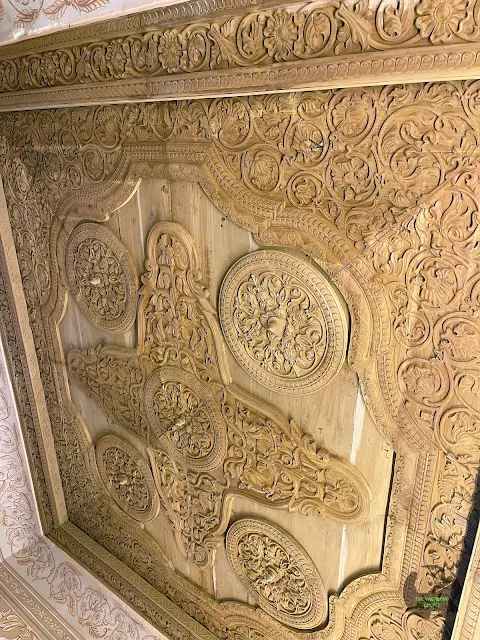 |
| Patwon Ki Haveli |
Housed within one of the havelis is a museum showcasing artifacts, documents and photographs that shed light on the history of the Patwa family and the construction of the havelis. This exhibit offers a deeper understanding of the cultural and societal context of the era.
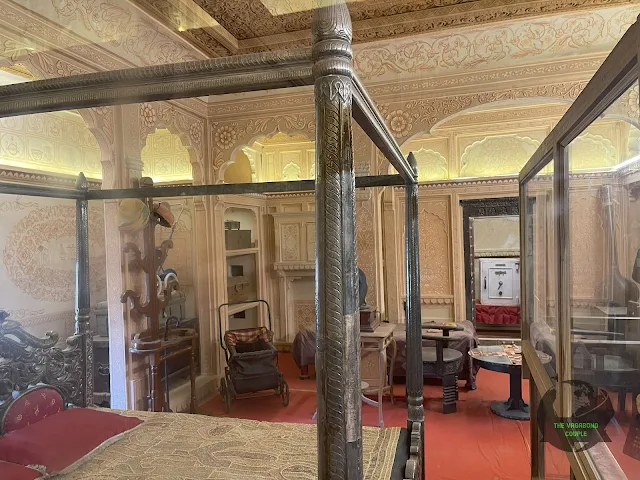 |
| Patwon Ki Haveli |
While the Patwon ki Haveli complex in Jaisalmer doesn't have entire rooms with mirrored ceilings, their use of mirrors to create dazzling visual effects is definitely a noteworthy feature.
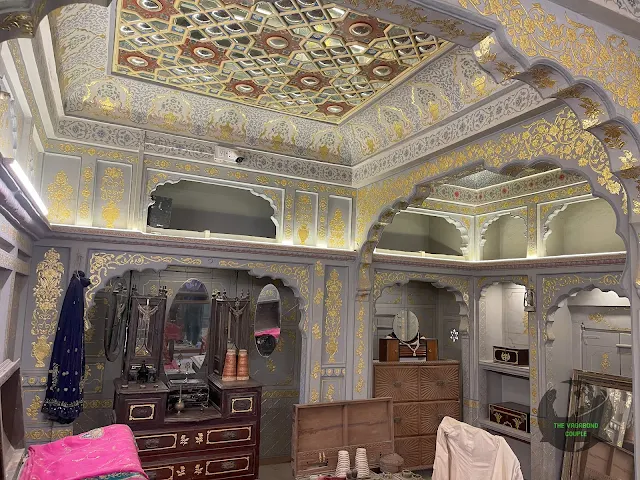 |
| Patwon Ki Haveli |
Instead of fully mirrored ceilings, the Patwon ki Haveli showcases a strategic and artistic use of Mirrored Embellishments in various ways.
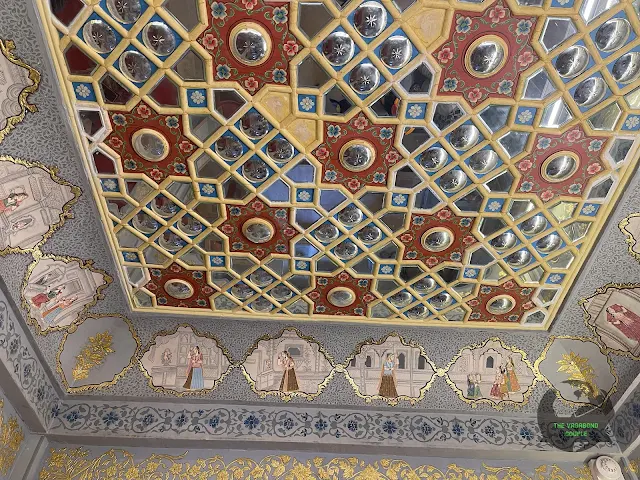 |
| Patwon Ki Haveli |
The Patwon ki Haveli complex boasts some truly impressive woodwork on its doors, further adding to the overall grandeur and artistic merit of these magnificent structures. These doors are not merely entry points; they are masterpieces of traditional Rajasthani woodworking, showcasing skilled craftsmanship and intricate designs. These doors are characterized by:
- Intricate Carvings: The doorways feature intricate carvings depicting various motifs, including floral patterns, geometric designs, mythological figures and animal figures. These carvings showcase the meticulous attention to detail and artistic talent of the artisans who created them.
- Variety of Woods: Different types of wood were used for the doors, each with its own unique grain and color. This adds visual interest and highlights the resourcefulness of the artisans. Examples include teak, rosewood and sheesham wood.
- Metal Embellishments: Many doors are further adorned with metal embellishments like brass or silver, adding a touch of opulence and durability. These embellishments might depict floral designs, geometric patterns, or even animal figures.
- Functional Elements: The doors also incorporate functional elements like knockers, latches and hinges, often designed in a way that complements the overall aesthetic.
The Patwon ki Haveli complex features several types of doors, each with its own unique design and purpose:
- Grand Entrance Doors: These large and imposing doors mark the main entry points of the havelis and are often the most elaborately decorated. They feature intricate carvings, metal embellishments and sometimes even painted panels.
- Interior Doors: Doors leading to different rooms within the havelis are smaller but still showcase beautiful carvings and designs. These might depict specific themes relevant to the room's purpose, like floral motifs for a women's chamber or animal figures for a hunting room.
- Jali Doors: Some doors feature jali work, intricate latticework that allows for ventilation and light while maintaining privacy. These jali panels might be adorned with geometric patterns or floral motifs.
The elaborate woodwork on the doors at Patwon ki Haveli serves several purposes:
- Aesthetic Appeal: The intricate carvings and designs add to the overall beauty and grandeur of the havelis, reflecting the wealth and status of the Patwa family.
- Cultural Significance: The motifs and designs often depict stories from Hindu mythology or local folklore, showcasing the cultural heritage of the region.
- Craftsmanship Display: The doors stand as a testament to the skill and artistry of the Rajasthani woodworkers, preserving traditional techniques for future generations.
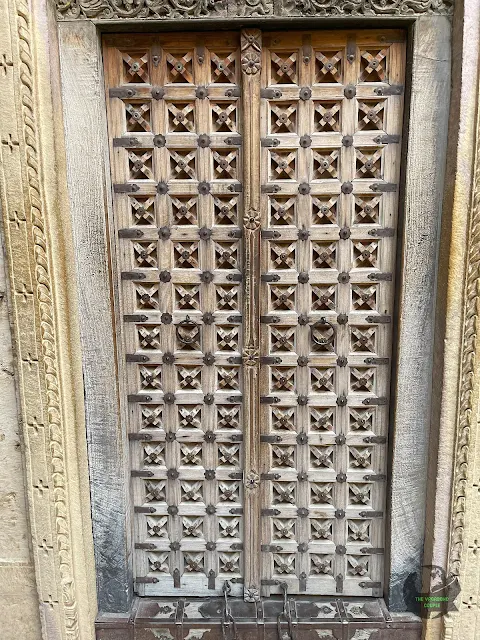 |
| An Interior Door at Patwon Ki Haveli |
The Patwon ki Haveli complex boasts a variety of wall paintings that contribute to its rich cultural and artistic tapestry. While not as extensive as some other historical sites in Rajasthan, these paintings still offer a glimpse into the lives and beliefs of the Patwa family and the era they lived in.
Floral and geometric patterns are commonly found, often adorning borders, doorways and niches. These add a touch of color and vibrancy to the spaces.
Paintings like the one below depicting hunting scenes, musical performances, or courtly gatherings offer a glimpse into the lifestyle of the affluent Patwa family.
 |
| Stylized Depictions of Courtly Life Wall Painting and Utensils at Patwon Ki Haveli museum |
Some paintings depict scenes from Hindu epics like Ramayana and Mahabharata, or local folktales. These offer insights into the religious and cultural beliefs of the time. Images of peacocks, elephants and other animals are often symbolic, representing prosperity, strength and other virtues. Appreciate the paintings not just for their aesthetic value, but also for their historical and cultural significance.
The balconies are supported by ornately carved pillars, adding to the overall elegance and structural strength of the havelis.
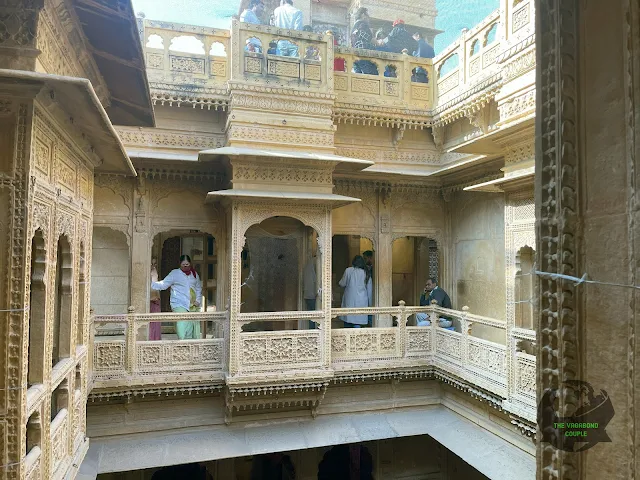 |
| Patwon Ki Haveli |
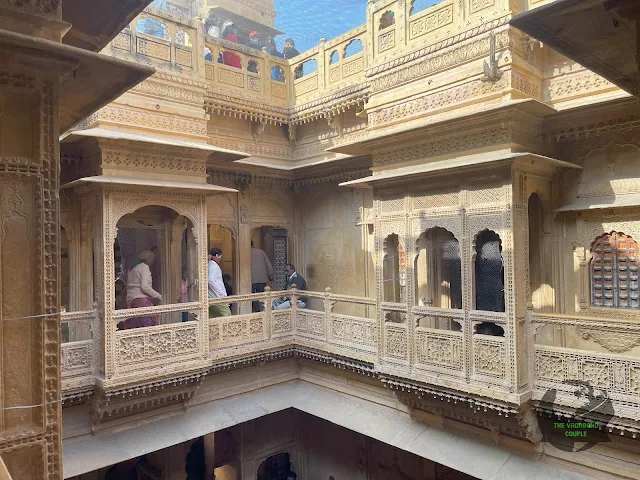 |
| Patwon Ki Haveli |
These balconies, adorned with intricate jali work (latticework) and supported by ornate pillars, are not just decorative elements; they served multiple purposes in the bygone era:
- Climate Control: The balconies provided shade and natural ventilation, keeping the havelis cool during the scorching summer months.
- Social Hub: The balconies served as social spaces for the women of the Patwa family to interact with each other and observe activities in the courtyard below.
- Aesthetic Appeal: The balconies added to the overall grandeur and architectural beauty of the havelis, showcasing the wealth and status of the Patwa family.
 |
| Patwon Ki Haveli |
For visitors exploring Patwon Ki Haveli, the wraparound balconies offer an immersive experience. Walking through the haveli and ascending to the upper levels provide opportunities to closely observe the craftsmanship, feel the cool desert breeze and appreciate the architectural nuances.
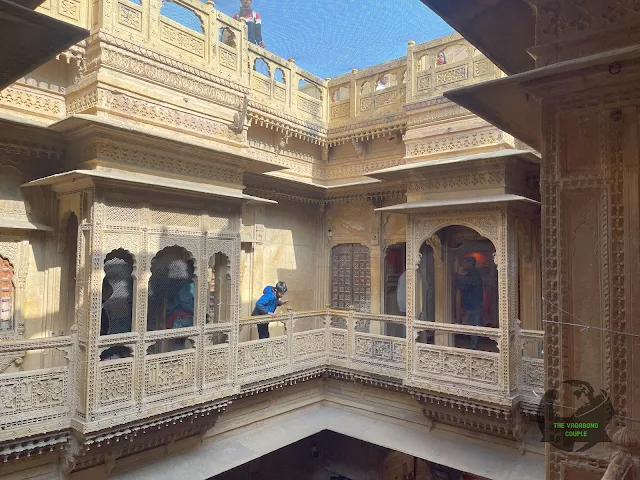 |
| Patwon Ki Haveli |
Small, strategically placed niches within the walls and ceilings are inlaid with mirrors, reflecting light and creating an illusion of spaciousness. Some sections of the ceilings, particularly around the edges, might be adorned with mirrored borders, adding a touch of sparkle and grandeur.
 |
| Patwon Ki Haveli |
Mirrored pieces are incorporated into intricate floral and geometric patterns, creating dazzling reflective surfaces that enhance the visual complexity of the ceilings. Some of the grand halls boast ornate chandeliers adorned with mirrored pieces, reflecting light and adding to the opulent atmosphere.
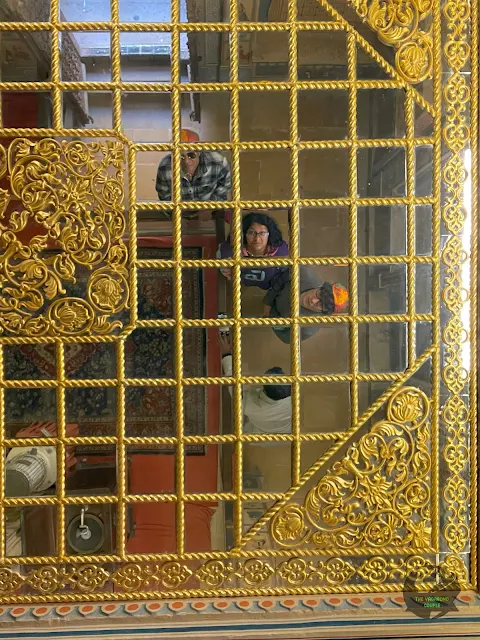 |
| Patwon Ki Haveli |
We come across a huge and richly decorated Pachisi game board in one of the luxurious rooms of the Haveli museum. Pachisi, also known as Chaupar or Parcheesi, is indeed a fascinating game with a rich history and cultural significance in India, particularly in Rajasthan, whose origins trace back to the 4th century AD or possibly even earlier. References to a similar game called "Pasha" appear in the epic Mahabharata.
Initially enjoyed by royalty and nobility, Pachisi gradually spread across social classes, becoming a beloved pastime for all ages. Over time, regional variations emerged, each with unique board designs, rules and names. In Rajasthan, it's often called "Pasha" or "Chaupar".
The American corporation Hasbro, headquartered in Rhode Island, USA, has been granted a copyright and trademark for "Parcheesi" whose game board and play are directly based on the ancient Indian game. The classic Pachisi board resembles a symmetrical cross with numbered squares and designated starting and finishing points. Traditionally, players used cowrie shells for movement, but dice became common later.
Players strategically move their pawns around the board based on die rolls or cowrie shell throws, aiming to reach the finish point first. Pachisi requires a blend of strategic thinking, planning and a dash of luck, making it an engaging game for players of all skill levels.
Pachisi transcends simply being a game. It serves as a social activity, bringing people together and fostering interaction across generations and social barriers. The game embodies traditional leisure activities and social customs, offering a glimpse into India's rich cultural heritage. Exquisitely hand-painted boards, often made of wood or cloth, showcase the artistic expression and craftsmanship of local artisans.
Witnessing locals playing Pachisi in streets, courtyards, or tea shops offers an authentic cultural encounter.
 |
| Pachisi board and pieces |
Climb to the rooftop for panoramic views of the Jaisalmer Fort, the Thar Desert and the bustling cityscape. Imagine the grand celebrations and starlit evenings enjoyed by the Patwa family from this vantage point.
 |
| Views from roof terrace of Patwon Ki Haveli |
Witness the mesmerizing play of light and shadow on the intricate carvings as the sun moves throughout the day, creating a dynamic and ever-changing visual experience.
If you're visiting in the evenings, you might encounter local artisans showcasing their talents outside the havelis. This is a great opportunity to support local crafts and take home a unique souvenir.
Tips for Visiting Patwon ki Haveli
The Patwon ki Haveli complex is open from 9:30 AM to 6:30 PM.
- Consider visiting early in the morning or later in the afternoon to avoid peak crowds.
- Entry fees are nominal.
- Photography is allowed in most areas, but be respectful of privacy and avoid using flash within the havelis.
- Wear comfortable shoes as you'll be doing some walking on uneven surfaces.
By immersing yourself in the architectural grandeur, intricate details and captivating history of the Patwon ki Haveli, you'll gain a deeper appreciation for the rich cultural heritage of Jaisalmer and the bygone era it represents.
Patwon Ki Haveli stands as an architectural masterpiece, a living testament to the wealth and artistic prowess of the merchants who once called Jaisalmer home. As the desert winds whisper through its ornate balconies and the golden sun bathes its sandstone walls, Patwon Ki Haveli continues to enchant and inspire, inviting travelers to immerse themselves in the rich tapestry of Rajasthan's cultural and historical heritage.
We sit down for a late lunch at the Jaisal Treat on Bera Road. Laal Maas and Bajra ki Roti again, of course and we order India's famous lager called Kingfisher.
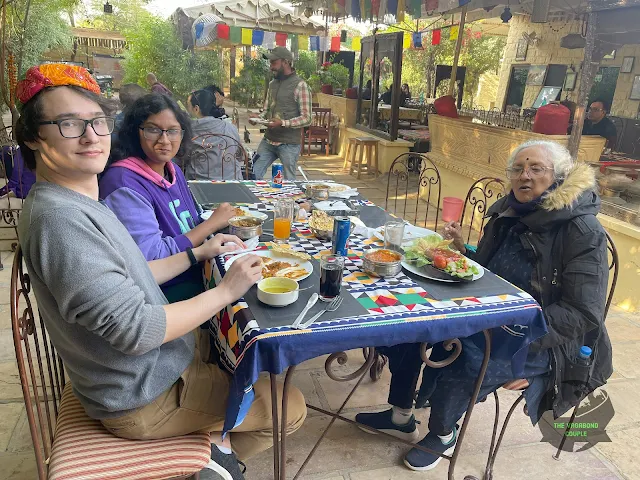 |
| Jaisal Treat Restaurant |
We head back to our tent camp in the Sam sand dunes some 40 km west of Jaisalmer (a story we tell at "A Desert Expedition to Sam Sand Dunes of Thar Desert of Rajasthan: Tent Camping, Camel Safari, Jeep Rides and ATV Adventures") and call it a night. The Great Indian Thar Desert paragliders are also returning to terra firma by the time we reach our tent.
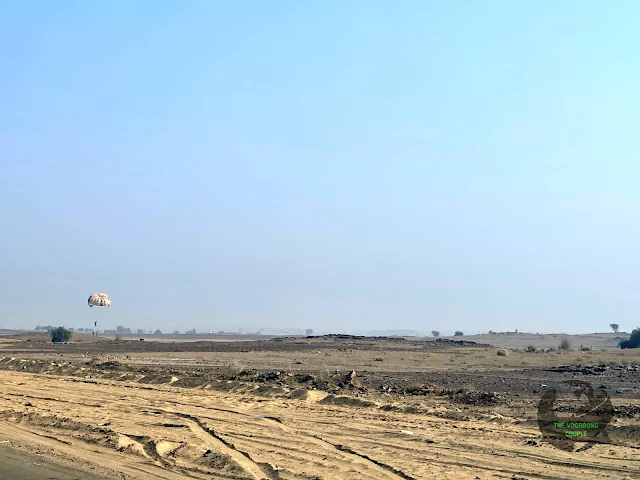 |
| Paragliding at Sam Sand Dunes on Thar Desert |
Jaisalmer, with its golden fortress and rich cultural heritage, offers a captivating journey through time. Whether exploring the intricacies of the Jaisalmer Fort or experiencing the magical sunset at the Sam Sand Dunes, visitors are sure to be enchanted by the allure of this golden jewel in the heart of the Thar Desert.


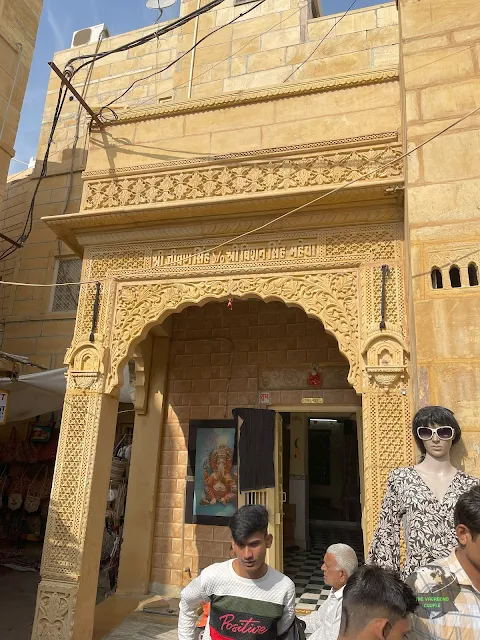

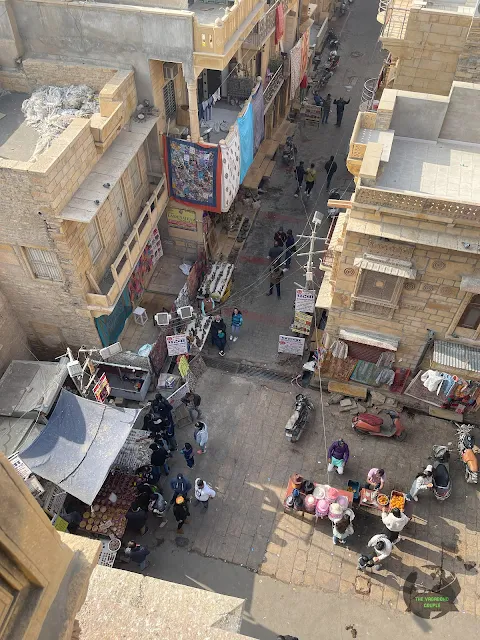

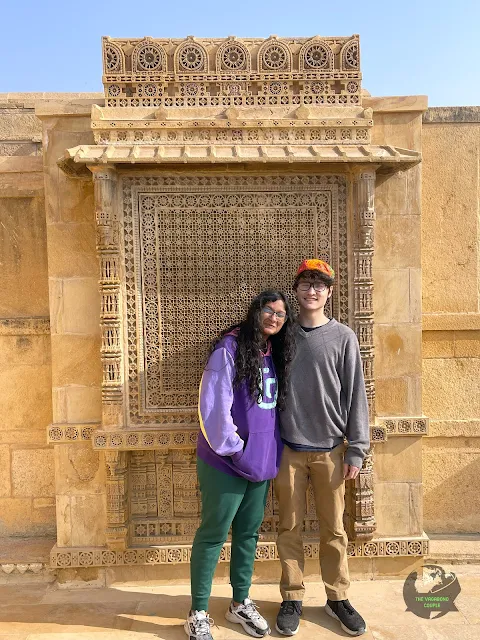

0 comments